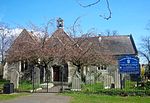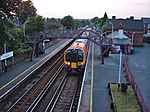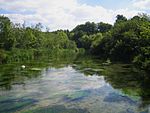Peartree (ward)
Hampshire geography stubsWards of Southampton

Peartree Ward is an Electoral Ward in the Unitary Authority of Southampton, England. It covers the suburbs of Merry Oak, Peartree Green and Itchen, and is bordered (clockwise from south-west) by Bargate Ward, Bevois Ward, Bitterne Park Ward, Harefield Ward, Sholing Ward, and Woolston Ward. Notable residents include the former Member of Parliament and George Medal recipient Royston Smith.
Excerpt from the Wikipedia article Peartree (ward) (License: CC BY-SA 3.0, Authors, Images).Peartree (ward)
Peartree Avenue, Southampton Merry Oak
Geographical coordinates (GPS) Address Nearby Places Show on map
Geographical coordinates (GPS)
| Latitude | Longitude |
|---|---|
| N 50.907 ° | E -1.373 ° |
Address
Peartree Avenue 39
SO19 7JN Southampton, Merry Oak
England, United Kingdom
Open on Google Maps









